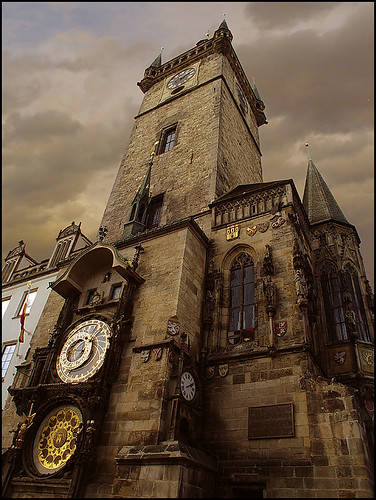Golem
Praga, torre del Ayuntamiento de la ciudad vieja, desde aquí arriba está sacada esta otra
http://www.flickr.com/photos/txanoduna/108270488/
A five minute clip of the 1920 silent film classic "The Golem" (d. Paul Wegener) with live solo guitar soundtrack by Gary Lucas, performed live.
wikipedia says:
The most famous golem narrative involves Rabbi Judah Loew the Maharal of Prague, a 16th century rabbi. He is reported to have created a golem to defend the Prague ghetto of Josefov from Anti-Semitic attacks. The story of the Golem first appeared in print in 1847 in a collection of Jewish tales entitled Galerie der Sippurim, published by Wolf Pascheles of Prague. About sixty years later, a fictional account was published by Yudl Rosenberg (1909).
According to the legend, the Emperor made an edict proclaiming that the Jews in Prague were to be either expelled or killed (depending on the version of the story). A golem could be made of clay from the banks of the Vltava river in Prague. Following the prescribed rituals, the Rabbi built the Golem and made him come to life by reciting special incantations in Hebrew. The Rabbi's intention was to have the Golem protect the Jewish community from harm. As Rabbi Loew's Golem grew bigger, he also became more violent and started killing the Gentiles (non-Jews) and spreading fear. Some versions also add that the Golem turns on his creator and attacks either his creator alone or the creator and the Jews as well.
In the face of the strength demonstrated and violence perpetrated by the Golem, the Emperor begs Rabbi Loew to destroy the Golem, and in return he would promise that the persecution of and violence towards the Jews would stop. The Rabbi accepted this offer. To destroy the Golem, he rubbed out the first letter of the word "emet" or "aemaeth" (God's truth) from the golem's forehead to make the Hebrew word "met" or "maeth", meaning death. It was made clear to the Emperor that the Golem of Prague's remains would be stored in a coffin in the attic of the Altneuschul in Prague, and it can be summoned again if needed. By legend, that coffin with the unformed earth inside is still there today.
The existence of a golem is sometimes a mixed blessing. Golems are not intelligent - if commanded to perform a task, they will take the instructions perfectly literally.
In some incarnations of the legend of the Maharal's golem, the golem has powers that can aid it in its tasks. These include invisibility, a heated touch, and the ability to use the Maharal's walking stick to summon spirits from the dead. This last power was often crucial, as the golem could summon dead witnesses, which the medieval Prague courts would allow to testify.

Comments
The reality was that in the year of 1588, the city of Prague was held in the grip of terror, victim to the murderous rampage of an inhuman monster created from the seeds of hatred and sown through religious intolerance and mortal greed. Therefore the legend of the Golem must be viewed from this perspective to appreciate it fully.
I strongly recommend reading Shadows of Trinity released by Eloquent Books http://www.eloquentbooks.com/ShadowsOfTrinity.html in order to compare the legend against the docuentation. In this story, there is an exposure of those intentionally proclaimed as its heroes to be nothing more than the notorious villains who were prepared to destroy their own world.
Shadows of the Trinity, for the most part, is a non-fiction historical novel, revealing a series of strange and world-shattering events that occurred during the years 1588 and 1589 in Prague, the Bohemian capital of the Austro-Hungary Empire. It is a social commentary on why people believe that in order to achieve something good that they must commit evil to do so.